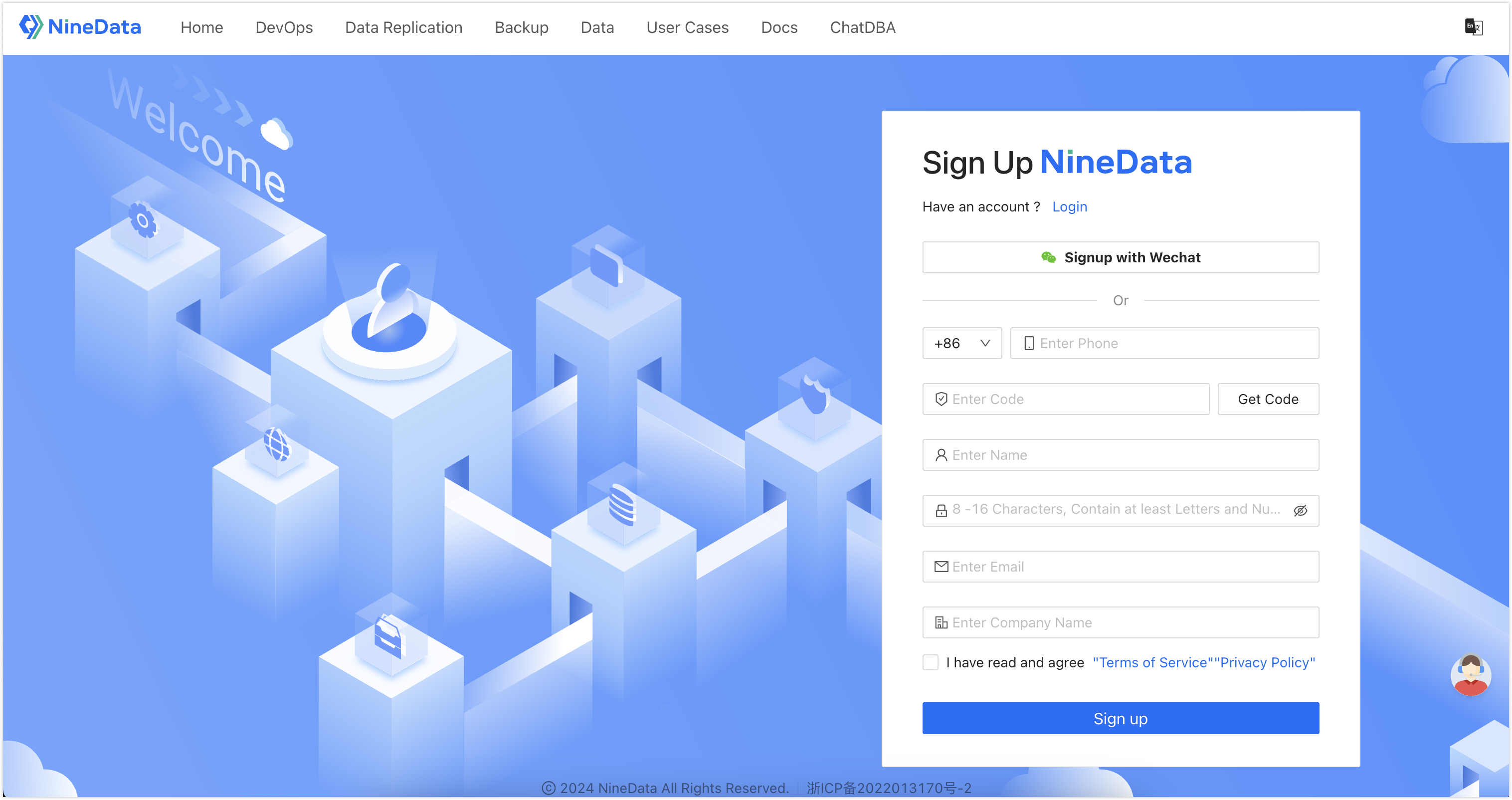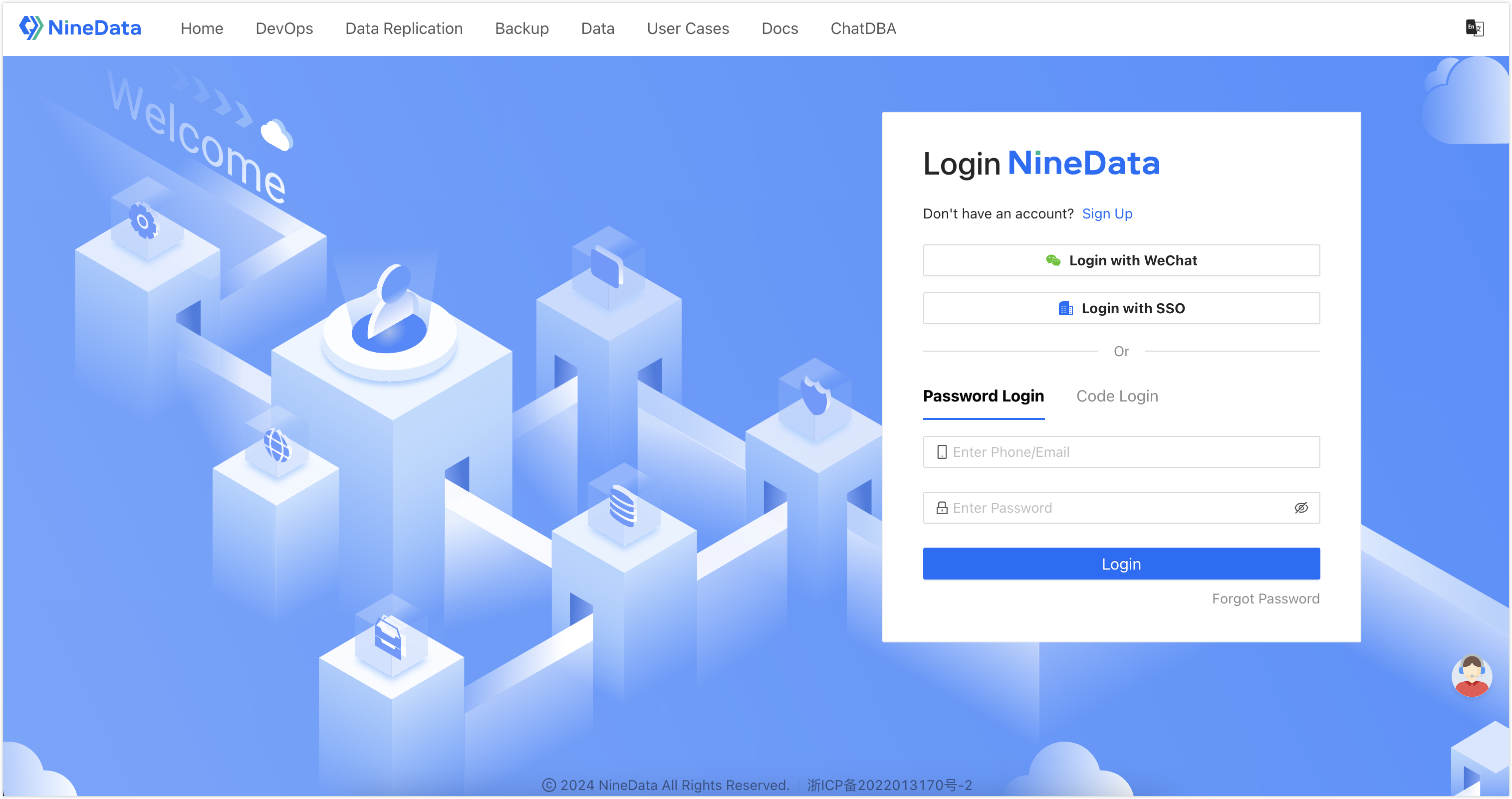Step-by-Step Guide to Quickly Migrate SQL Server Data
This article introduces how to migrate data from a SQL Server database to another SQL Server database using NineData's data replication feature, starting from scratch.
Please select your scenario to jump to the operation steps that suit you:
Step One: Register for a NineData Account
Open the NineData Registration Page.

Enter your phone number and click Get Verification Code, then enter the verification code sent by the NineData system after receiving it.
tipOnly phone numbers from Mainland China are currently supported. If you are using a phone number outside the +86 area, you can only receive the verification code via email.
Enter your username and password.
tipThe password strength requirements are as follows:
The password can contain letters, numbers, and special characters.
Length is 8~16 characters.
Must contain both letters and numbers.
Cannot contain empty characters (spaces).
Enter your email and company name, read the Terms of Service and Privacy Policy carefully, then check the box in front of , and click .
tipIf you have already entered your email in the above steps, you do not need to enter it again.
Step Two: Log in to NineData
Open the NineData Login Page.

You can choose to log in via , , , or .
- : Enter the phone number or email used during registration, and enter the password, then click .tip
- If you are using a phone number outside the +86 area, you cannot log in via phone number at the moment. Please use the email you registered with to log in.
- If you have forgotten your login password, you can click in the lower right corner to .
- Click , enter the phone number used during registration, click , and enter the verification code sent by the NineData system, then click .tip
If you are using a phone number outside the +86 area, please enter the email you registered with to receive the verification code.
: Log in to NineData via SSO. For more information, please refer to Log in to NineData via SSO.
- : Log in to NineData by scanning the WeChat QR code.
- : Enter the phone number or email used during registration, and enter the password, then click .
Step Three: Enter SQL Server Source and Target Data Sources
This section introduces how to connect to SQL Server data sources via the public network. You can choose the connection method that suits your actual situation.
Log in to the NineData Console.
On the left navigation pane, click > .
- Click tab, and click on the page. In the popup window for selecting the data source type, choose (Data Source Deployment Type) > (the type of data source to be added), and configure the parameters based on the table below on the page.tip
If you make a mistake during the operation, you can click the
icon at the top of the page to make a new selection.
| Parameter | Description |
|---|---|
| Enter the name of the data source. To facilitate subsequent searching and management, please use a meaningful name. | |
| Select . | |
| Enter the public connection address and port of the SQL Server source data source. | |
| The username of the SQL Server source data source, which must have the permission to read the data to be migrated. | |
| The password of the SQL Server source data source. | |
| Choose the region closest to your data source location to effectively reduce network latency. | |
| Keep the default settings. | |
| Keep the default settings. |
After all configurations are completed, click next to to test whether the data source can be accessed normally. If prompted with , you can click to complete the addition of the data source. Otherwise, please recheck the connection settings until the connection test is successful.
Repeat the above steps to add the SQL Server target data source.
tip- The version number of the SQL Server target data source must be greater than or equal to the source data source.
- The username used to log in to the target data source must have read and write permissions for the target data source.
Step Four: Create a Replication Task
In the left navigation bar of the NineData console, click .
On the page, click on the page.
On the tab, configure according to the table below and click .
Parameter Description Enter the name of the data synchronization task. To facilitate subsequent searching and management, please use a meaningful name. Up to 64 characters are supported. Select the SQL Server source data source. Select the SQL Server target data source. Keep the default state, i.e., select and . Keep the default state, i.e., select . On the tab, select the libraries to be replicated in (this example is
daily_test_source), click theicon to add it to , and then click .
On the tab, click .
On the tab, wait for the system to complete the precheck, check , and then click .
tip- If the precheck does not pass, you need to click in the column on the right side of the target check item, investigate the cause of the failure, manually fix it, and then click to re-execute the precheck until it passes.
- Check items with as can be fixed or ignored according to the situation.
On the page, if prompted with , click to view the execution of each stage of the synchronization task.
Step Five: View the Comparison Results of the Source and Target Data Sources
After the replication task is executed, you need to compare the data on both ends to ensure the consistency of the data after migration with the data in the source.
On the page, click the tab.
By clicking the or button, you can switch the comparison results of the table structure and data.